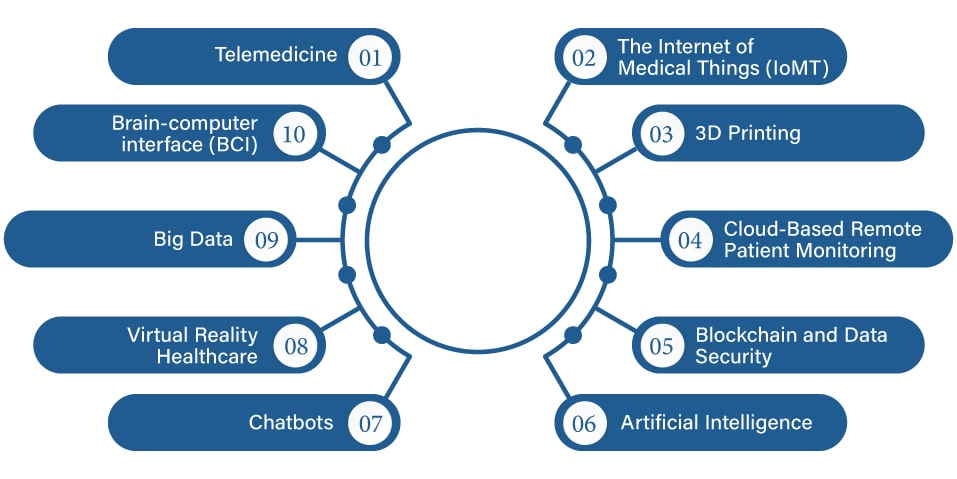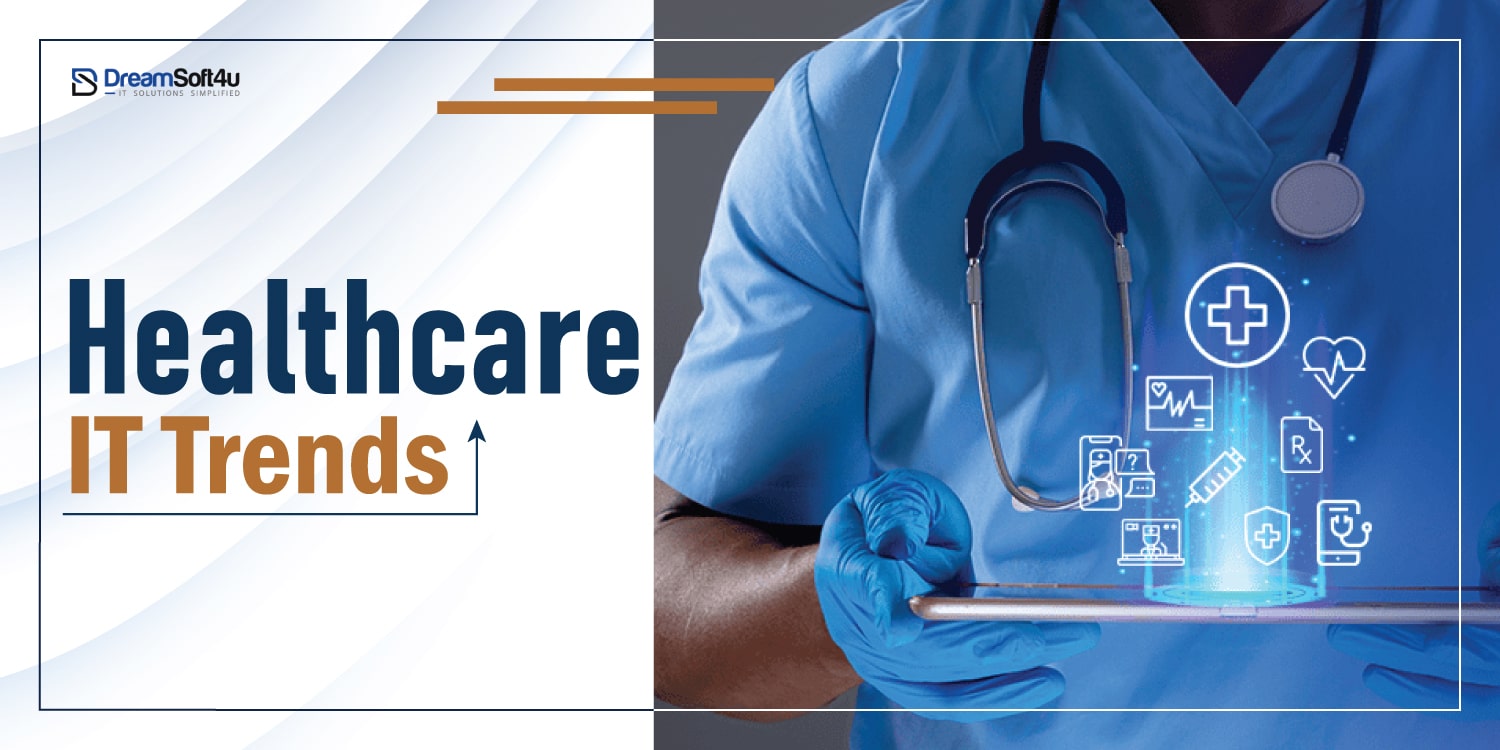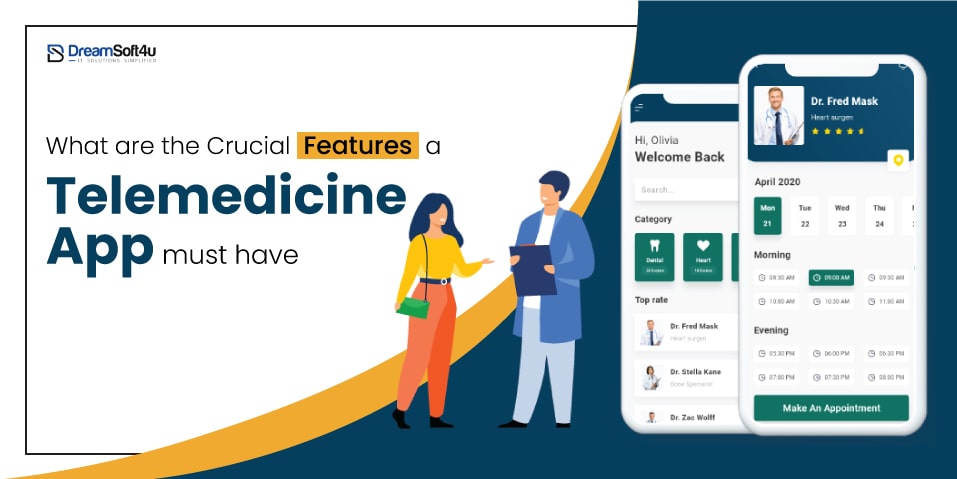2025 is here, and it’s time to explore the top healthcare IT trends. What’s something that is both good and bad in technology? It keeps evolving and keeps getting better. Healthcare services too should keep up pace with them.
As per marketsandmarkets research, the global health tech market will reach nearly USD 668.2 billion in 2025. Implementing new healthcare IT trends helps providers and related businesses to:
- Improve patient care journeys
- Enhance diagnosis speed and accuracy
- Keep patient data secure and well-protected
- Identify care bottlenecks using AI and data tools
- And improve almost every aspect of healthcare (including revenue)
In this blog, we will see some key technology trends. These healthcare IT trends are all set to transform healthcare. Below we have put together the main sections of the blog (in case you want to skip some).
Table of Contents
ToggleTop Healthcare IT Trends

Trend 1: Telemedicine
Perhaps, few technology trends have made as big an impact on healthcare accessibility as telemedicine has over the last few years. Remember how telemedicine platforms were the healthcare lifeline during the pandemic?
Well, five years later they are on top of every healthcare IT trend list for 2025. But why?
According to a recent report on Medical Appointments, the wait time for underserved populations in urban areas has risen from 18.5 to 24 days since 2014. Telemedicine can be a game changer on this front.
As the internet reaches more people, the telemedicine platform could help break healthcare distance barriers. People in rural communities and below-par economies could use this technology to access quality healthcare from where they are.
Also, many telehealth platforms come with an EHR (Electronic health record) feature. It makes it simpler for specialists to forward documents. This can mean the difference, in rural areas, between having or not having expert input into a case.
Trend 2: The Internet of Medical Things (IoMT)
The market for wearable medical devices is not just big but also pretty fast-growing. Various research has predicted a CAGR of around 25-28% for the next 5 years. That will take the market size to $428 billion by 2030.
Today there are a range of wearable devices and smartphone applications for monitoring and preventing disease. IoMT covers several smart devices: ECG, EKG monitors, smart beds, wireless inhalers, and many more.
IoMT lets doctors focus on prevention care over and above everything else. Instead of doing a once-a-year check-up, patients can receive more regular health updates. As a result, healthcare providers have access to real-time health monitoring of high-risk patients through wearable tech.Providing consistent communication within the Internet of Things devices ecosystem is the industry’s biggest challenge nowadays. The devices generate massive amounts of data, and their handling creates a problem for producers who rely on proprietary protocols. Plus, the industry has yet to address the slow and failed connections.
Trend 3: 3D Printing
3D printing technology is the next big frontier in healthcare technology. It supports manufacturing, design, and prototyping sectors in the healthcare field. 3D printing will also play a crucial role in dentistry and orthodontics, as well as in surgery in 2025.
Through 3D printing, physicians can:
- Replicate specific organs and drill guides,
- Create patient-specific replicas of bones, tissues, and blood vessels
- Develop safe prosthetic limbs
- Print tissues and organs for transplant
Overall, the 3D printing capabilities Help doctors prepare better for procedures as well as overcome organ(as well as other ) shortages during transplants and key medical procedures. Moreover, large-scale adoption will make transplants simpler and more cost-efficient.
Trend 4: Cloud-Based Remote Patient Monitoring
Remote Patient Monitoring is another important cloud-based application that uses smart wearables and biosensors to help track individuals in real time. These solutions help to monitor vital stats remotely and alert a care provider proactively in a scenario where anomalies are observed.
In cases of heart attacks or other health-related emergencies, medical paramedics will arrive at the doorway. It will be activated with the Healthcare Provider getting automatic triggers running.
Trend 5: Blockchain and Data Security
The enormous volume of health data generated from wearables and sensors has brought new challenges such as interoperability, data integrity, security, and privacy. By placing the patient in the middle of the healthcare ecosystem, blockchain technology can help solve these challenges and, in turn, will help the patient gain more control over their health data. When it comes to EHRs, blockchain can help avoid changes or stolen patient data by the use of a special security protocol.
DreamSoft4u Since 2003
Get your free quote by the top professionals.
Trend 6: Artificial Intelligence
You’ve probably seen this one coming. It’s no secret that AI is becoming increasingly common across industries, especially in healthcare. Artificial intelligence has multiple applications in healthcare environments, from being used in treatments to designing treatment plans.
For example, an emergency care facility may use AI to allow patients to respond electronically to questions about themselves. Instead, this knowledge can be used to decide if the patient is in the right place — maybe they will be better treated in an emergency room or retail clinic instead. This tool can ensure that you spend your time serving patients in need of your help, and it can help others get the best care possible, rather than sitting in a waiting room.
Trend 7: Chatbots
Using AI-backed messaging and voice systems to deal with routine queries can help organizations realize cost savings. In healthcare, the ability to deal with easily diagnosed problems enables professionals to focus on matters that may require a physician’s full attention. Patients also benefit from the feeling that questions were simply put to the test.
Practices dealing with older patients may also benefit from chatbots. A character can be developed which will serve as a friendly reminder assistant. The assistant can even warn of potential drug interactions by connecting with other technologies, such as analytics and AI.
Chatbots are already revolutionizing the business world, and they can also be predicted to be a major part of the digital healthcare transition. Any of the threats need to be paid attention to. Automated systems should not be seen as replacements for expert opinions, especially when the risks involve patient threats.
Trend 8: Virtual Reality Healthcare
You can experience some form of AR and VR features in the e-commerce segment. But its larger implications will be experienced in healthcare. This is one of the top healthcare IT trends for 2025.
AR and VR will make remote healthcare truly immersive!
Imagine a virtual clinic with 3D avatars of patients, doctors, and other caregivers. And this is not merely a sight for the eyes. Instead, with AI and IoT integration, virtual healthcare is expected to go to a whole new level. Therefore, you must look for the best IoT development company for services.
Trend 9: Big Data
Whenever we say the term “Big Data”- the first word that comes to our mind is volume. Of course, it is true but only partly. What we tend to miss is the velocity and variety of healthcare data that is collected from different consumer and clinical-based resources. This includes smartwatches, EHR systems, Pharmaceutical Research, Medical Imaging, and much more.
But what makes “Big Data” such a significant healthcare IT trend in 2025?
- Big data can help doctors diagnose disease earlier (before it becomes a threat).
- Providers can also use the insights to create personalized treatment plans.
- This helps in improving care outcomes and the patient experience at large.
Other than these benefits, Big Data will also transform drug discovery, and preventive care, and lower healthcare costs as well.
Trend 10: Brain Computer Interface (BCI)
This had to be on our list, and we had to keep it for the last. But this could well be the first on the list. The only reason it isn’t is because the technology is still in its early stages. But 2025 could be a breakthrough year!
How BCI works?
“BCI captures the brain’s electrical signals and then translates them into computer commands.“
If you have heard about “Neauralink”, then you probably know what we are talking about. The application and promise of the Brain-computer interface (BCI) is huge!
- Restoring Movement and Communication
- Treating Neurological Conditions
- Pain Management
- Sensory Restoration
- Cognitive Enhancement
Get Your Own Custom Healthcare Software For Your Business!
We’ve a team of experts to deliver you a tailored solution.
Wrapping Up
So that brings us to the end of the list. What do you think? Which of these healthcare IT trends in 2025 redefine healthcare?
If you are a healthcare service provider or a business owner who deals in the healthcare segment, we can help you leverage these trends to your benefit.
DreamSoft4U Pvt Ltd is a leading healthcare software development company in India. Our best services include Telemedicine App Development, EMR Integration, and Wearable App Development. We have been in the industry for 20+ years, and have to our credit 500+ healthcare IT projects.
Our developers have extensive experience and expertise in trending healthcare technology stack and our engagement models are flexible. Let’s discuss your needs and build your project!
Contact Team DS4U today!
FAQs
Q1. Can 3D Printing create personalized organs?
Yes, it can. We can use the patient’s cells to create organs. This reduces the risk of organ rejection. However, the technology is still new and under trial.
Q2. Are there any challenges for Big Data?
There are three challenges for Big Data:
- Data Privacy: Healthcare software should meet HIPAA and other compliances.
- Data Security: Healthcare data, especially in motion, such as telehealth appointments must be well protected.
- Data Sharing: Interoperability between healthcare providers and systems can be a challenge due to privacy concerns.
Q3. Do you have any white-label healthcare software products?
Yes, we have white-label products for telehealth platforms, EMR systems, Hospital patent management, and more.
Q4. Can I get a demo of your white-label products?
Yes, we do offer white-label product demos to prospective clients. You can book your product demo by visiting our Contact Us page.
Q5. How can I hire healthcare software developers from DS4U?
We have different engagement models. Let us discuss your needs and we will suggest the right fit for your project need.



















